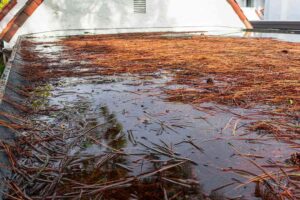Introduction
Maintaining a robust and durable roof is pivotal for any commercial building. Proper roof maintenance can save your business from unexpected costs and downtime. A meticulous roof inspection can identify potential issues before they become significant problems, ensuring the longevity and safety of your building. Below is a comprehensive commercial roof inspection checklist that will help you keep your roof in prime condition.
1. Pre-Inspection Preparation
Before starting with the actual inspection, it’s important to gather all necessary tools and documents. Ensure you have the following:
- Safety gear (harness, gloves, helmet)
- Inspection forms/checklists
- Camera or mobile device for documentation
- Flashlight
- Binoculars
- Moisture meter
2. Exterior Inspection
A thorough inspection of the exterior is crucial. Begin with a visual examination from the ground using binoculars and then proceed to a closer view if safe.
2.1 Surface Material Examination
Check the roof surface for:
- Cracks and Blisters: These can indicate underlying moisture problems.
- Warping and Punctures: Signs of material strain that might need immediate attention.
2.2 Flashings and Edges
Inspect:
- Flashings: Ensure they’re securely in place without gaps or rust.
- Edges: Look for signs of lifting or separation, which can compromise roof integrity.
3. Interior Inspection
The interior inspection can often reveal problems that are not visible from the outside.
3.1 Ceiling and Wall Inspections
Check:
- Water Stains: Indicative of leaks.
- Mold and Mildew: Signs of prolonged moisture exposure.
- Structural Deformation: Such as sagging ceilings, which might be due to water damage.
3.2 Insulation Checks
Inspect the insulation for:
- Moisture: Wet insulation can reduce energy efficiency and indicate leaks.
- Damage or Displacement: Ensuring it’s intact and in its proper place is essential for effective thermal control.
4. Drainage System
Proper drainage is essential to prolong the roof’s life.
4.1 Gutters and Downspouts
Ensure:
- Clog-Free Systems: Regularly clean gutters and downspouts.
- Proper Attachment: All components should be securely attached to prevent detachment during storms.
4.2 Rooftop Drains
Check for:
- Blockages: Clear any debris.
- Water Flow: Ensure water is draining properly to avoid ponding.
5. Roof Protrusions and Penetrations
Any object protruding from the roof, including HVAC units, skylights, or vents, needs careful inspection.
5.1 Seals and Joints
Inspect:
- Seal Integrity: Look for gaps or cracks in seals.
- Joint Condition: Ensure joints are secure and water-tight.
5.2 Equipment Stability
Ensure:
- Secure Fastening: All equipment should be firmly affixed.
- Corrosion Check: Inspect metal components for rust or corrosion.
6. Document Findings
Documenting your findings is vital for future reference and repair planning.
6.1 Detailed Records
Keep records of:
- Inspection Dates
- Observed Issues
- Photographic Evidence
6.2 Maintenance Log
Maintain a log for:
- Performed Repairs
- Scheduled Maintenance
Conclusion
A well-maintained roof protects your business’s assets and ensures operational continuity. Regular inspections, like the one outlined in this checklist, are crucial. For professional help, consider partnering with North End Contracting, a top-tier service provider.
Proper commercial roof maintenance can significantly extend the life of your roof, from roof repair in St. Paul to installations and replacements. Investing in regular inspections and timely repairs with a trusted St. Paul roofing contractor like North End Contracting can yield substantial long-term benefits.
Whether you’re dealing with a flat roofing system in St. Paul, MN, or any other type of commercial roofing, this checklist will keep your roof in optimal condition, safeguarding your investment for years to come.
Stay proactive with your roof maintenance to avoid unexpected costs and ensure longevity. This guide is your first step to a healthy and durable commercial roo

